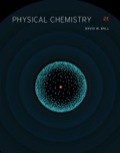
Concept explainers
(a)
Interpretation:
The angles of diffraction for a cubic crystal for the given incoming X radiation are to be calculated.
Concept introduction:
A unit cell of the crystal is the three-dimensional arrangement of the atoms present in the crystal. The unit cell is the smallest and simplest unit of the crystal which on repetition forms an entire crystal. The parameters of a crystal can be obtained experimentally by X-ray diffraction technique.
Answer to Problem 21.64E
The table that represents the miller indices and corresponding value of diffraction angle is shown below as,
| Miller indices |
Diffraction angle |
Explanation of Solution
The wavelength of the given X-ray is
The given lattice parameter is
The value of
The Bragg equation for diffraction of X rays is given by an expression as shown below.
Where,
•
•
•
•
•
Rearrange the equation (1) for the value of
The value of
| Miller indices |
Diffraction angle |
|
The table that represents the miller indices and corresponding value of diffraction angle is shown below as,
| Miller indices |
Diffraction angle |
(b)
Interpretation:
The diffractions that would be absent if the given crystal were body-centered cubic or face centered cubic are to be determined.
Concept introduction:
A unit cell of the crystal is the three-dimensional arrangement of the atoms present in the crystal. The unit cell is the smallest and simplest unit of the crystal which on repetition forms an entire crystal. The parameters of a crystal can be obtained experimentally by X-ray diffraction technique.
Answer to Problem 21.64E
The diffractions that would be absent if the given crystal was body-centered cubic are represented in the table shown below.
| Miller indices |
Diffraction angle |
The diffractions that would be absent if the given crystal was face-centered cubic are represented in the table shown below.
| Miller indices |
Diffraction angle |
Explanation of Solution
From Table
The Miller indices of diffractions those are present in body centered cubic crystal are
Therefore, the diffractions that would be absent if the given crystal was body-centered cubic are represented in the table shown below as,
| Miller indices |
Diffraction angle |
|
From Table
The Miller indices of diffractions those are present in face centered cubic crystal are
Therefore, the diffractions that would be absent if the given crystal was face-centered cubic are represented in the table shown below as,
| Miller indices |
Diffraction angle |
|
The diffractions that would be absent if the given crystal was body-centered cubic are represented in the table shown below.
| Miller indices |
Diffraction angle |
The diffractions that would be absent if the given crystal was face-centered cubic are represented in the table shown below.
| Miller indices |
Diffraction angle |
Want to see more full solutions like this?
Chapter 21 Solutions
EBK PHYSICAL CHEMISTRY
- How does the square root mean square velocity of gas molecules vary with temperature? Illustrate this relationship by plotting the square root mean square velocity of N2 molecules as a function of temperature from T=100 K to T=300 K.arrow_forwardDraw product B, indicating what type of reaction occurs. F3C CF3 NH2 Me O .N. + B OMearrow_forwardBenzimidazole E. State its formula. sState the differences in the formula with other benzimidazoles.arrow_forward
- Draw product A, indicating what type of reaction occurs. F3C CN CF3 K2CO3, DMSO, H₂O2 Aarrow_forward19) Which metal is most commonly used in galvanization to protect steel structures from oxidation? Lead a. b. Tin C. Nickel d. Zinc 20) The following molecule is an example of a: R₁ R2- -N-R3 a. Secondary amine b. Secondary amide c. Tertiary amine d. Tertiary amidearrow_forwardpls helparrow_forward
- pls helparrow_forward35) Complete the following equation by drawing the line the structure of the products that are formed. Please note that in some cases more than one product is possible. You must draw all possible products to recive full marks! a. ethanol + 2-propanol + H2SO4 → b. OH conc. H2SO4 CH2 H3C CH + K2Cr2O7 C. d. H3C A pressure CH3 + H2 CH Pt catalystarrow_forward21) The rate of reaction depends upon: a. the concentration and nature of reactants b. the temperature of the reaction C. whether or not a catalyst was used d. all of the above 22) A Maxwell-Boltzmann curve shows the distribution of molecular energies in a reaction system. When the temperature in this system is increased, the peak is a. higher and further to the right. b. higher and further to the left. c. lower and further to the right. d. lower and further to the left. 23) Which of the following correctly describes the reaction represented by the reaction below? CaCO3 (s) + energy → CaO (s) + CO2 (g) a. It is exothermic and the potential energy is greater in the reactants than the products. b. c. It is exothermic and the potential energy is greater in the products than the reactants. It is endothermic and the potential energy is greater in the products than the reactants. d. It is endothermic and the potential energy is equal for the products and reactants.arrow_forward
 Physical ChemistryChemistryISBN:9781133958437Author:Ball, David W. (david Warren), BAER, TomasPublisher:Wadsworth Cengage Learning,
Physical ChemistryChemistryISBN:9781133958437Author:Ball, David W. (david Warren), BAER, TomasPublisher:Wadsworth Cengage Learning, Chemistry for Engineering StudentsChemistryISBN:9781337398909Author:Lawrence S. Brown, Tom HolmePublisher:Cengage Learning
Chemistry for Engineering StudentsChemistryISBN:9781337398909Author:Lawrence S. Brown, Tom HolmePublisher:Cengage Learning Chemistry: Principles and PracticeChemistryISBN:9780534420123Author:Daniel L. Reger, Scott R. Goode, David W. Ball, Edward MercerPublisher:Cengage Learning
Chemistry: Principles and PracticeChemistryISBN:9780534420123Author:Daniel L. Reger, Scott R. Goode, David W. Ball, Edward MercerPublisher:Cengage Learning


